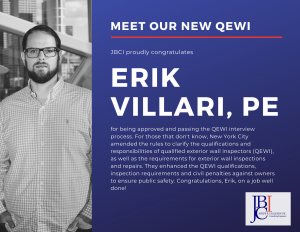In light of last month’s National Engineers Week (better late than never), JBCI Staff Engineer, Rebecca Gavin, EIT, a recent graduate of Rowan University partnered with the Girl Scouts of Central and Southern New Jersey (GSCSNJ) to help girls explore engineering careers.

Rebecca, as well as many other female leaders, worked with girls ranging from Daisies (K-1) to ambassadors (11-12) and their families in a fun bridge building activity as part of GSCSNJ STEAM month. As part of an ongoing relationship with the GSCSNJ, Rebecca, a former girl scout herself, will be participating in a STEM panel discussion during Women in Construction Week to help mentor young women in engineering and construction related careers and opportunities.

#NationalEngineersWeek #WomeninConstructionWeek
It has been said that 90 percent of all water intrusion occurs within 1 percent of the total building exterior. Water damage and the associated problems are extremely costly and cause significant interruptions to your facilities. Quickly identifying the water intrusions source(s) in existing buildings can be challenging and requires a knowledge of the in-situ building envelope construction. Our goal is to educate facility managers on methods to identify, mitigate and repair water intrusion into existing buildings. We also aim to educate managers on some of the common design and construction façade waterproofing pitfalls and relatively inexpensive ways to prevent them.
It is important to understand the basic behavior of the two main façade construction types, 1) barrier wall and 2) cavity wall. Common construction includes brick masonry, Exterior insulation and finish system (EIFS), precast, curtainwalls and concrete. Proper waterproofing at the interface between the building envelope elements include roof, façade, windows, foundations and plazas.
Understanding of how each building envelope component interacts with one another is key to identifying how water can travel within a wall. Then we can better identify the source of the leaks and effective corrective actions. Without this knowledge, there is a high probability that money will be wasted on improperly designed and constructed repair measures, and the water intrusion and interior damage will continue.
Let’s face it, parking garage structures are not exciting. They are often considered utilitarian and may be ignored. All parking garages require routine cleaning and maintenance to preserve and extend the service life of the structure. However, maintenance of parking garages is often deferred in favor of buildings. This deferred maintenance can lead to premature distress and deterioration and cause more extensive and costly repairs for an Owner or Operator.
Parking garage structures are subject to a very hostile environment and experience more distress and deterioration than a building. Similar to bridges, garages must resist vehicle traffic, weather, moisture, temperature fluctuations, ultraviolet light and deicing chemicals. A parking structure’s ability to resist these elements, and its general long-term performance is primarily influenced by a maintenance program.
All parking garages must have a routine maintenance program. This maintenance program should be considered preventative and will help reduce the overall repair costs over the life of the garage. The maintenance program tasks should be identified to occur on daily, weekly, quarterly or an annual frequency. These maintenance tasks will usually be performed by Owner or Operator personnel using prepared checklists.
A good maintenance program starts with an annual visual inspection of the garage. The annual inspection can be performed by Owner or Operator personnel or a professional consultant. During this annual inspection, any distress or deterioration conditions (i.e. cracks, sealant damage, water intrusion, etc.) must be recorded on checklists and garage plans. Once identified, the Owner or Operator should initiate a repair program to address any observed distress or deterioration conditions.
Another important aspect in a maintenance program is regular cleaning and washing of the parking garage. A complete washdown of the garage floors should be performed on a bi-annual basis (i.e. Spring and Fall). This will help remove accumulated dirt and debris from the garage on a regular basis. The Spring washdown is especially important to remove road salts and deicing chemicals that are brought into the garage during the winter months.
Finally, every maintenance program should include a structural assessment of the garage by a professional consultant every three to five years. The frequency of this assessment will greatly depend upon the age and condition of the parking garage. Following this assessment, the professional should provide prioritized repair recommendations and a probable construction cost for any identified repairs. This will allow the Owner or Operator to plan and budget for any necessary repairs. Repair programs for parking garages can be challenging, but when well planned, they can be done efficiently and minimize the disruption of garage operations.
 JBCI proudly congratulates Erik Villari, PE for being approved and passing the QEWI interview process. For those that don’t know, New York City amended the rules to clarify the qualifications and responsibilities of qualified exterior wall inspectors (QEWI), as well as the requirements for exterior wall inspections and repairs. They enhanced the QEWI qualifications, inspection requirements and civil penalties against owners to ensure public safety. Congratulations, Erik, on a job well done!
JBCI proudly congratulates Erik Villari, PE for being approved and passing the QEWI interview process. For those that don’t know, New York City amended the rules to clarify the qualifications and responsibilities of qualified exterior wall inspectors (QEWI), as well as the requirements for exterior wall inspections and repairs. They enhanced the QEWI qualifications, inspection requirements and civil penalties against owners to ensure public safety. Congratulations, Erik, on a job well done!
With three drone pilots on staff, JBCI is able to take you to new heights. We can help save time and money! For more information click here.
 The Philadelphia Business Journal has released its 2019 Book of Lists and JBCI is included once again! Our firm achieved 36th among the area’s Engineering Firms based on local licensed engineers.
The Philadelphia Business Journal has released its 2019 Book of Lists and JBCI is included once again! Our firm achieved 36th among the area’s Engineering Firms based on local licensed engineers.
This inclusion is coming off a big year for JBCI where we welcomed an expanded full time staff and part time staff to help support and match record-breaking growth in 2017 and 2018. To another great year!
 Last week, JBCI attended the Drexel University Engineering and Technology Career Fair. Newly hired engineer Robert “Bobby” Garneau, EIT (Class of 2018) and Principal Jessica Clifford, PE (Class of 2006) spoke with Civil and Architectural Engineering students graduating in 2019 with interests in forensic engineering, building envelopes, structural design, and architecture. It was exciting for both Bobby and Jess to return to their alma mater and reconnect with past teachers and friends as well as share their career experiences and expertise.
Last week, JBCI attended the Drexel University Engineering and Technology Career Fair. Newly hired engineer Robert “Bobby” Garneau, EIT (Class of 2018) and Principal Jessica Clifford, PE (Class of 2006) spoke with Civil and Architectural Engineering students graduating in 2019 with interests in forensic engineering, building envelopes, structural design, and architecture. It was exciting for both Bobby and Jess to return to their alma mater and reconnect with past teachers and friends as well as share their career experiences and expertise.
JBCI is currently hiring for Staff Engineers and Project Managers. Visit our career page for more information!

Joseph B. Callaghan, Inc. welcomes Robert “Bobby” Garneau, EIT to the team as our newest Staff Engineer. Bobby joins JBCI after completing Bachelors of Science degrees in Civil and Architectural Engineering at Drexel University. His studies focused on structural engineering, with interests in forensic structural analysis, green building technologies, and architectural history.
Outside of the classroom, Bobby enjoyed sports the most; playing intramural flag football, volleyball, and softball. He also worked as a Building Manager for the Dakalaskas Athletic Center. He seeks to further his education and has earned credentials as an Engineer In Training (EIT) and a LEED Green Associate.
Bobby loves to spend time outdoors hiking and biking, watching football, and working out at the gym. He also enjoys exploring new places, going to concerts, and cooking food.
From all of us at JBCI, welcome to the team Bobby!

We are happy to congratulate JBCI’s newest Professional Engineer – Michael Salera, PE!
Mike has been on the JBCI team as an EIT, Engineer in Training, for the past six years. Upon recently passing the Principles and Practice of Engineer exam, he has become a PE in Delaware. This new accomplishment reminds us that the pursuit of knowledge and honorable excellence runs through everything we do at JBCI.
We look forward to a successful future for Mike as a Senior Project Engineer. His willingness to take on challenges for customers will continue to position JBCI as your partner to help defeat complex building challenges.
We wish you great career ahead, Mike!
– The JBCI Team



 JBCI proudly congratulates Erik Villari, PE for being approved and passing the QEWI interview process. For those that don’t know, New York City amended the rules to clarify the qualifications and responsibilities of qualified exterior wall inspectors (QEWI), as well as the requirements for exterior wall inspections and repairs. They enhanced the QEWI qualifications, inspection requirements and civil penalties against owners to ensure public safety. Congratulations, Erik, on a job well done!
JBCI proudly congratulates Erik Villari, PE for being approved and passing the QEWI interview process. For those that don’t know, New York City amended the rules to clarify the qualifications and responsibilities of qualified exterior wall inspectors (QEWI), as well as the requirements for exterior wall inspections and repairs. They enhanced the QEWI qualifications, inspection requirements and civil penalties against owners to ensure public safety. Congratulations, Erik, on a job well done! The Philadelphia Business Journal has released its
The Philadelphia Business Journal has released its  Last week, JBCI attended the
Last week, JBCI attended the 
